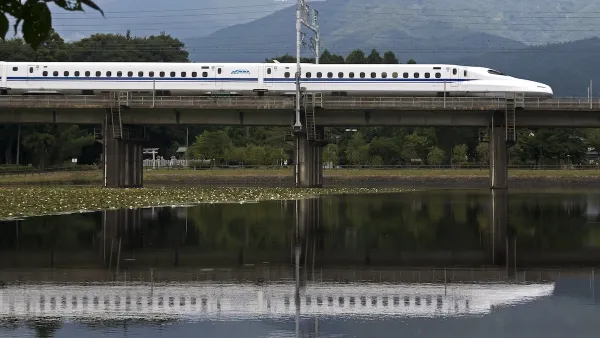Transportation reporter Tom Belden of the Philadelphia Daily ponders how and where the $8 billion in stimulus funds allotted to high-speed rail should be spent, referencing a report by the Progressive Policy Institute.
"In the 1990s, the U.S. Department of Transportation identified California and a dozen other states as places with corridors, with metro areas of sufficient size at either end, where fast trains would work well to take traffic off highways and out of the air.
There is interest in developing systems in several of those corridors, including one in Texas linking Dallas, Houston and San Antonio, and another in the Midwest connecting Chicago to Detroit, Minneapolis, and St. Louis. California has the most advanced high-speed rail (not maglev) project going today, with a plan to link major cities with
an 800-mile network of trains traveling as fast as 220 m.p.h.
The Northeast is the only part of the country that already has relatively high-speed trains, with Amtrak providing sufficient competition to airlines that it has the largest share of passengers traveling between New York and Washington."
"The left-leaning Progressive Policy Institute, in a research paper released just before Obama took office, argued for federal aid to
high-speed rail as a way to create construction and other jobs, relieve air and highway congestion, save energy, and help reduce greenhouse-gas emissions."
Thanks to Bay Area Transportation News
FULL STORY: Winging It: Stimulus raises hopes for high-speed trains

Planetizen Federal Action Tracker
A weekly monitor of how Trump’s orders and actions are impacting planners and planning in America.

Restaurant Patios Were a Pandemic Win — Why Were They so Hard to Keep?
Social distancing requirements and changes in travel patterns prompted cities to pilot new uses for street and sidewalk space. Then it got complicated.

Map: Where Senate Republicans Want to Sell Your Public Lands
For public land advocates, the Senate Republicans’ proposal to sell millions of acres of public land in the West is “the biggest fight of their careers.”

Maui's Vacation Rental Debate Turns Ugly
Verbal attacks, misinformation campaigns and fistfights plague a high-stakes debate to convert thousands of vacation rentals into long-term housing.

San Francisco Suspends Traffic Calming Amidst Record Deaths
Citing “a challenging fiscal landscape,” the city will cease the program on the heels of 42 traffic deaths, including 24 pedestrians.

California Homeless Arrests, Citations Spike After Ruling
An investigation reveals that anti-homeless actions increased up to 500% after Grants Pass v. Johnson — even in cities claiming no policy change.
Urban Design for Planners 1: Software Tools
This six-course series explores essential urban design concepts using open source software and equips planners with the tools they need to participate fully in the urban design process.
Planning for Universal Design
Learn the tools for implementing Universal Design in planning regulations.
Heyer Gruel & Associates PA
JM Goldson LLC
Custer County Colorado
City of Camden Redevelopment Agency
City of Astoria
Transportation Research & Education Center (TREC) at Portland State University
Camden Redevelopment Agency
City of Claremont
Municipality of Princeton (NJ)





























